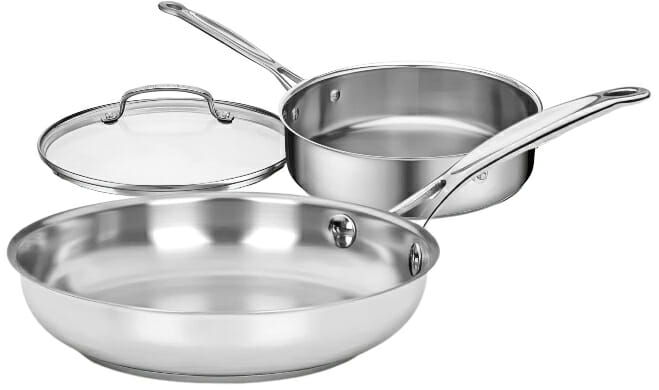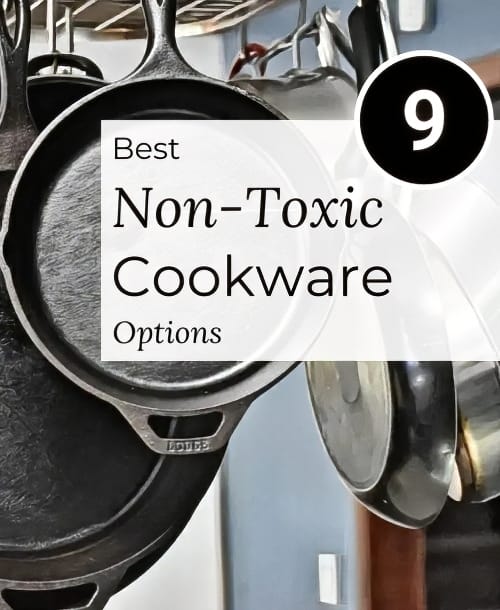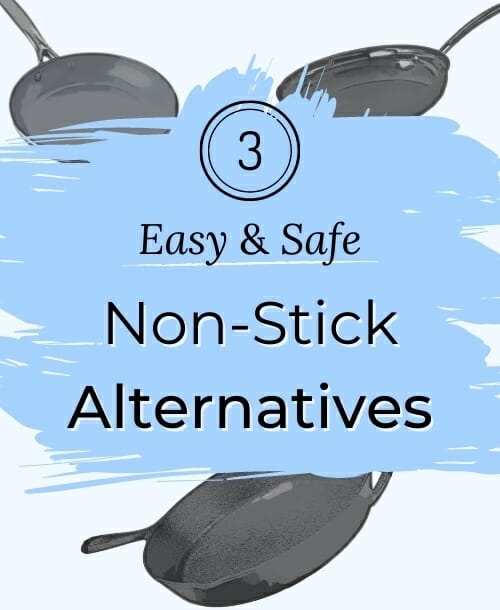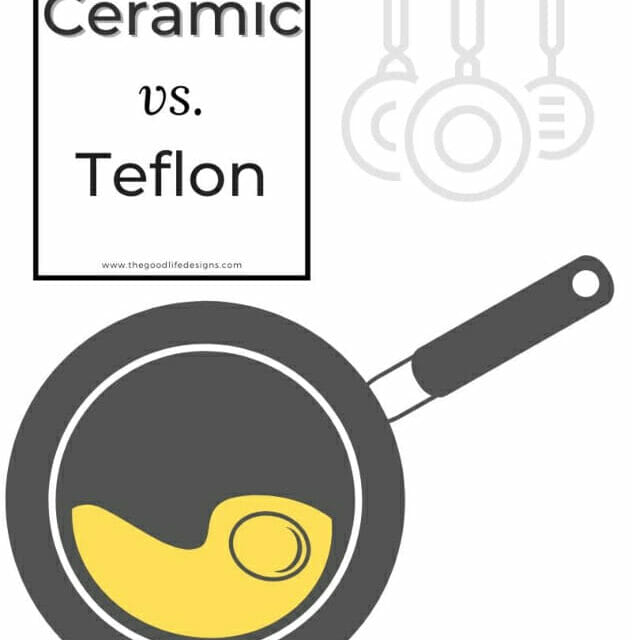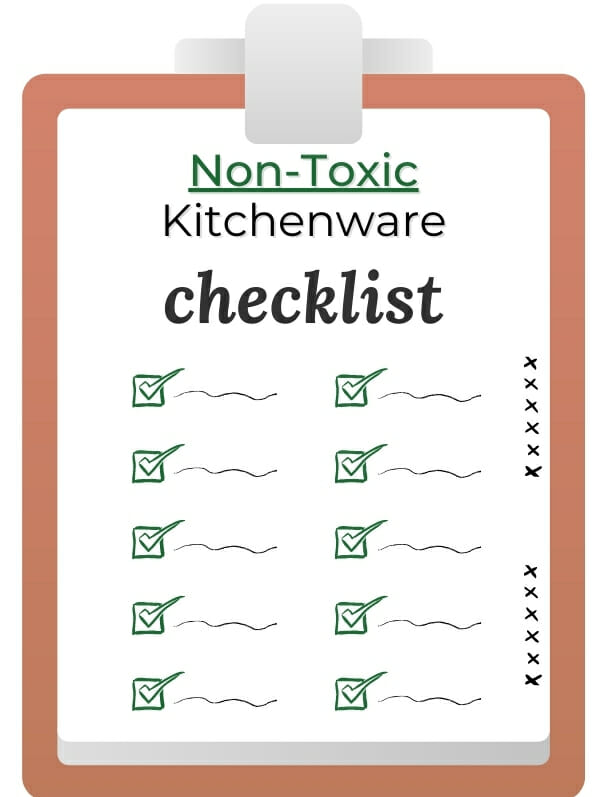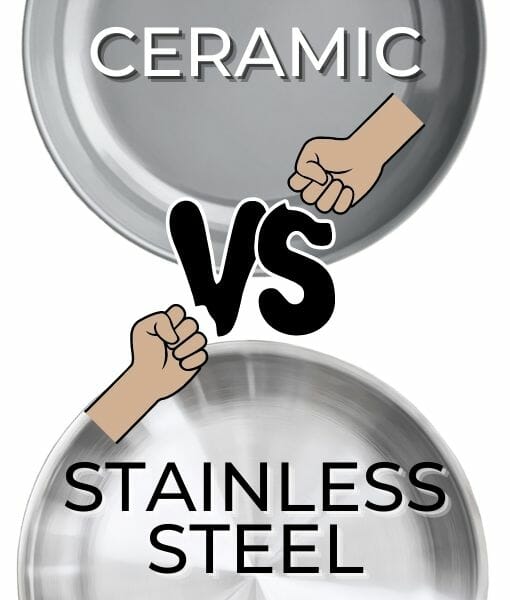
So, you’re considering ceramic vs stainless steel cookware but aren’t sure which to pick? You probably know that Teflon is some dangerous stuff, but now you’re left with questions like…
Is ceramic cookware safer than stainless steel?
Is stainless steel cookware better than ceramic?
The answer is – it depends. Your decision boils down to what you cook and how you cook it. You don’t want to waste cash on the wrong type.
So, you’re going to discover the advantages and disadvantages of both ceramic and stainless steel cookware.
Then, who each is best for.
This way, you make the right choice… The first time!
Let’s get started.
Ceramic Vs Stainless Steel Cookware – What to Consider
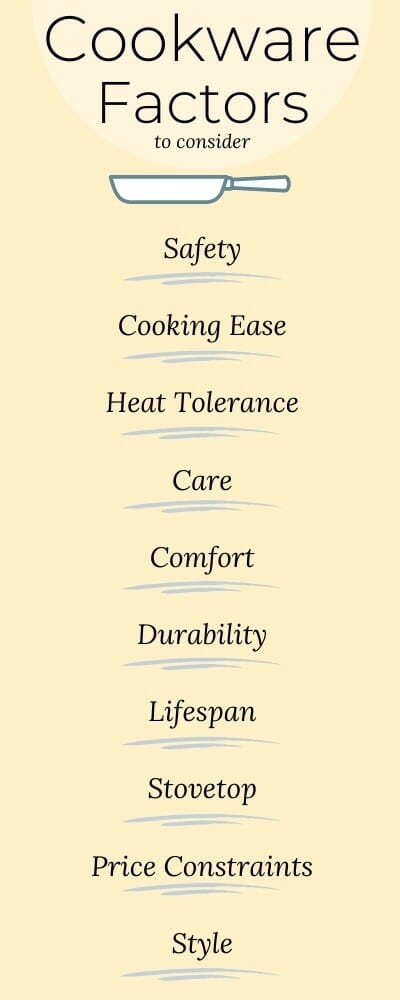
When you’re debating ceramic vs stainless steel pots and pans, it’s vital to consider a few things.
Nothing is worse than blowing hard-earned cash on the wrong choice.
Picture this, you buy a whole new cookware set and realize you hate it after a few weeks. But since there’s already some usage, you’re unable to get a refund.
Keep the following factors in mind so you don’t wind up with cookware that collects dust in your cabinet.
Then, after that, we’ll dive into the pros and cons of ceramic and stainless steel.
Safety
By this point, It’s no mystery that Teflon cookware is hazardous when overheated and worn out.
So we want something safe and NOT Teflon. Both ceramic and stainless steel cookware make healthier alternatives.
Cooking Ease
Not everyone is Gordon Ramsay. So a non-stick pan is excellent for beginner cooking and easy cleaning.
Heat Tolerance
What do you cook? Non-stick pans are great for delicate foods, but not so great for high heat searing.
Care
I don’t know about you, but I prefer not to get a full workout while viciously scrubbing in the sink. Non-stick pans can solve that problem.
Stainless steel pans are harder to clean by hand, but they’re dishwasher-safe.
Comfort
Cool-touch handles will prevent a scorched hand.
Also, consider weight. Cast iron, for example, is weighty and hard to maneuver. Stainless and non-stick ceramic pans aren’t too heavy.
Durability
This is essential if you plan on using metal cooking utensils. In that case, a non-scratch pan (like steel) is best.
Lifespan
This ties into the last point.
Durable pans like stainless steel will last much longer and save you money in the long run. Unfortunately, non-stick pans usually don’t last too long – we’ll touch on that soon.
Stovetop Freedom
Consider the stovetop you have at home. Whatever you choose needs to be compatible (most ceramic pans are not induction-compatible, for example).
Also, consider oven-safe cookware for braising. That’s much harder to find in a non-stick pan, so stainless steel wins here.
Price constraints
What’s your budget?
This is probably the first question you should ask. In general, stainless steel cookware costs more than ceramic-coated.
Style
How cool do you want to look? Do you want to match your cookware to your kitchen paint?
Stainless steel provides a classy, luxurious shine. Yet ceramic gives you the freedom of endless color options. Hmmm.
Ceramic Cookware Pros and Cons
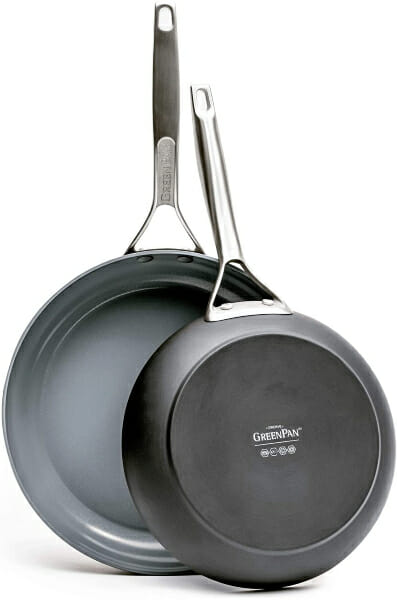
Now, let’s dive into ceramic pans’ pros and cons.
Then we’ll touch on the main benefits and some advice if you choose this type.
But keep this in mind below…
There are two different types of ceramic cookware. The most popular is ceramic-coated (non-stick). Less popular is pure ceramic.
For this post, we’re discussing ceramic non-stick cookware pros and cons, but we’ll touch on pure as well.
Moving on.
Ceramic Cookware Advantages
- Non-stick: Ceramic-coated pans are slick and beginner-cook friendly.
- Fewer calories: Because you won’t need cooking oils, you’ll reduce calorie intake.
- Easy to clean in seconds with a sponge.
- Chemical-free: Non-stick coating that’s free of those nasty toxic PFOA/ PTFE Teflon chemicals.
- Non-reactive with acidic or alkaline foods (No metallic tastes).
- Safe under high heat: Unlike Teflon’s breakdown at 464℉, non-stick ceramic is safe up to 800℉.
- Even & Efficient Heating: No cold spots, faster cooking, and less heat required to get the job done.
- Advanced Ceramic Coatings can handle the oven, unlike Teflon.
- A large variety of colors and patterns for a more personalized approach.
- Relatively affordable
Ceramic Cookware Disadvantages
- Avoid metal utensils
- Not-dishwasher-safe. (Harms the non-stick finish).
- A shorter lifespan than stainless steel or cast iron. At best, you’ll get 3-5 years of non-stick cooking.
- Low-medium heat only: Although safe under high heat, it can decrease the non-stick surface’s lifespan.
Ceramic Cookware Overview

Here’s the difference between pure ceramic vs ceramic-coated…
The former is 100% ceramic that’s baked in a kiln (like pottery class).
And ceramic-coated cookware is a sheet of aluminum or steel dipped in a ceramic mixture.
This process creates a smooth, non-stick finish – free of toxic chemicals.
One of the main benefits of ceramic cookware.
You can enjoy much easier, safer cooking, without the dead birds.
Pure ceramic cookware is much more expensive – but worth it. It’s scratch-proof, microwave, refrigerator, and dishwasher-safe. Plus, it handles up to 2500℉.
Non-stick ceramic pans, on the other hand, aren’t really safe with metal cooking utensils.
Now, titanium-reinforced coatings are said to be metal utensil-safe, but…
You should only use silicone, wood, or bamboo utensils for ceramic cookware. This will extend the non-stick coating’s lifespan.
You’ll want to avoid the dishwasher with non-stick ceramic.
But, some types ARE safe in the oven. (Make sure the lid and handle are oven-safe too).
GreenPan makes oven-safe ceramic pans.
With proper care, your ceramic pan’s lifespan will be about 3-5 years, as long as you only use it for delicate foods. (Think eggs or pancakes).
Advice & Care for Ceramic-coated Pans

- Make sure any colored ceramic is lead & cadmium-free. (This should be in the company’s FAQ section)
- Can you use non-stick spray in a ceramic pan? Nope. It’ll build up a hard-to-remove film, which will reduce the pan’s non-stick ability. Instead, use a dab of high smoke point oil if needed.
- Do not plunge your hot pan into cold water. Let it cool down before cleaning, or it’ll warp the pan and damage the coating.
- Use only warm soapy water and a non-abrasive sponge or cloth. (No steel wool).
- Use baking soda to release extra stuck-on foods and stains.
- Seasoning ceramic-coated pans isn’t necessary. But, it’s not a bad idea – it’ll increase the non-stick. Follow these steps.
- If the coating starts to crack or chip, or you see metal peeking through, it’s time to replace the pan.
Stainless Steel Cookware Pros and Cons
Now it’s time to touch on stainless steel pots and pans’ pros and cons.
Then, like before, a summary of stainless steel cookware’s benefits and some tips.
Let’s continue.
Advantages of Stainless Steel Cookware
- Coating-free, non-toxic surface that won’t chip or peel.
- Non-reactive with acidic or alkaline foods.
- Ridiculously durable: Steel pans are forgiving. They’re almost impossible to ruin.
- Dishwasher-safe, perfect for those lazy evenings (or maybe that’s just me).
- Versatile: You can do anything with stainless, from stir-frying to scorching hot steak searing. You can also cook delicate foods like eggs with proper heating and oil use.
- No special attention: Clean any way you’d like without worrying about the seasoning (like cast iron cookware).
- Heats faster than cast iron.
- Metal utensil-safe (remember, no coating).
- Oven-safe: But make sure the handle and lid are oven-safe as well.
- Creates amazing flavors due to the stuck-on, browned food bits.
- Recyclable.
Disadvantages of Stainless Steel Cookware
- Trial and error: Food sticks, so it’s less beginner-friendly. But, as you read above, this has its benefits (Plus, there’s a way to make steel “act” non-stick – stay tuned).
- Extra calories: You’ll need plenty of cooking oil to reduce sticking.
- Doesn’t conduct heat as well as ceramic. (Although multi clad pans with aluminum or copper inserts will solve that problem).
- Can stain or darken if you overheat your pan or burn cooking oil.
- Not allergy-friendly due to the nickel content.
- Pricey for a quality set.
Stainless Steel Cookware Overview
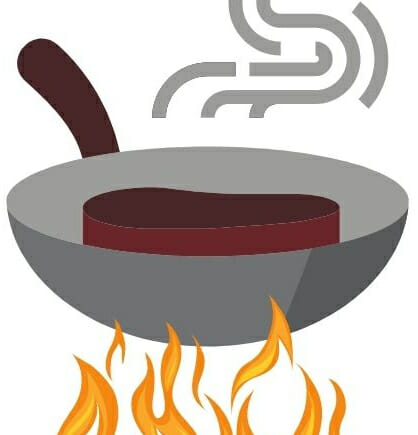
Stainless steel is a mixture of iron, carbon, chromium, and nickel.
The chromium and nickel are what make the stainless steel rust and corrosion-resistant.
You’ll notice phrases such as “18/10” stainless steel cookware.
The first number is the percentage of chromium, and the second number is nickel.
If you’re allergic to nickel, you’ll want this 21/0 nickel-free set. There’s no nickel, so it seems less corrosion resistant, but…
The high percentage of chromium (21%) makes up for it.
Now, yes, stainless steel cookware sticks.
But the benefits of cooking in stainless steel make it worthwhile.
You’ll get unmatched flavors not possible with non-stick cookware due to those caramelized food bits.
It’ll take a bit more practice, but once you get stainless down, you’ll enjoy some impressive dishes.
Plus, there are no coatings to worry about.
You can use any utensil and crank the heat as high as you want.
Seared steaks, anyone?
Steel pans share many of the same benefits as cast iron but weigh less and won’t rust.
Advice & Care for Stainless Steel Cookware

- Don’t force stuck-on food. It’ll release when it’s ready. For eggs, let them sit for a minute or so before moving them.
- Don’t submerge a hot steel pan in water, or it’ll warp. Let it cool first.
- To prevent sticking, do this: Preheat the (empty) pan for about 2-3 minutes. Then, add a thin layer of oil. When the oil starts to smoke a little or simmer, ONLY THEN add the food. Voila, you have a non-stick pan!
- For stubborn food bits, pour a thin layer of water in the pan and bring to a boil. The food should scrape off easily.
- Don’t use rough steel wool to clean. It can damage the surface and cause pitting. Instead, use a Scotch-Brite Pad or something similar.
- If you notice dark spots (from overheating) or white calcium build-up, use vinegar or Bar Keeper’s Friend to rub out the stain.
- If you notice copper or aluminum peeking through deep scratches, it’s time for a replacement.
Ceramic Vs Stainless Steel Pans – Final Comparison
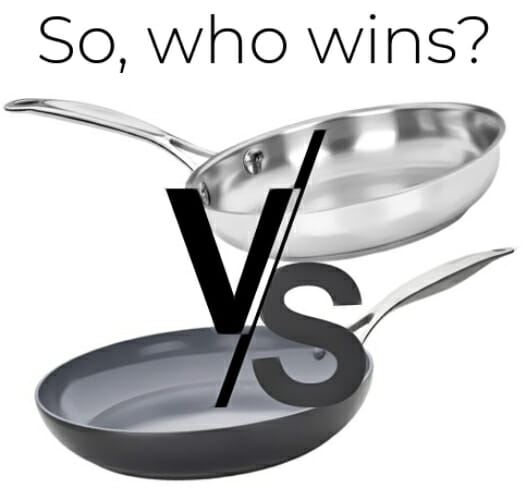
So, ceramic or stainless steel cookware? Who wins?
Now that you’ve seen each material’s pros, cons, and best practices, let’s wrap it up with a final comparison. Below are two simple bulleted lists to guide you in your selection.
Then, in the end, I’ll share my recommendation based on my experiences using both ceramic and stainless steel cookware.
Pick ceramic-coated if:
- You want an easy-cleaning pan.
- You cook a lot of eggs and other delicate foods at low to medium heat.
- You want to avoid excess calories and use little to no cooking oil.
- You want to cook meals faster, saving time and effort.
- You want more color options to match your kitchen.
Pick stainless steel if:
- You want to be able to check your pan in the dishwasher.
- You cook a wide variety of foods and want the freedom to sear at high temperatures.
- You want a pan that lasts forever, saving you money down the road.
- You have an induction cooktop (although some ceramic pans are induction-compatible).
- You don’t mind using oil or butter.
My Recommendation
Getting a full set of either is not always the best idea.
Instead, consider building a collection piece by piece.
You need to use a pan for a while before you can work out the kinks and determine if you like it or not.
It’s better not to commit to one type or the other.
But, if you had to pick only one stainless steel or ceramic pan, steel is your best bet as it’s the most versatile.
A great starting point would be to grab some quality, affordable ceramic cookware like GreenPan’s Lima for delicate foods…
Then, pair it with a durable multi-ply steel pan such as Cuisinart’s MultiClad Pro for everything else.
A simple ceramic and stainless steel combo for a healthy Teflon-free cookware will handle virtually any cooking need imaginable.
So, there you have it!
Everything you need to know about ceramic vs stainless steel cookware!
P.S. Steel and ceramic are only two out of nine healthy cookware options mentioned in our other post. Check it out here!

Hi there! I'm Adam, author and founder of TGL. Since 2016, I've produced and sold non-toxic kitchenware throughout the US. Today, I'm using my passion and experience in sustainable product manufacturing to help families avoid unsafe reusable foodware. When I'm not writing, you'll find me hiking or camping throughout Appalachia!
Enjoyed this post? Share it with your friends!
Related Posts
FREE Guide
Non-Toxic Kitchenware Checklist
Get a step-by-step product guide with insider tips & tricks for the safest kitchen possible!

